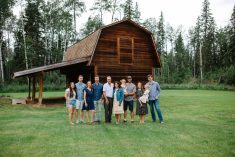Our Succession Advantage series continues by examining advantages you can achieve during the transition process of succession planning. To date, we have covered the benefits of establishing proper communication for maintaining family harmony, clarifying the financial expectations to develop a sustainable plan, and dedicating time to strategic business planning. For the December issue of Country Guide, we dive into the transition phase, quantifying transition options to provide clarity on the path forward and allowing family members to make better, more informed decisions about the future of the farm.
The Smith family owns a third-generation cash crop operation in central Ontario. Current owners, Larry and Fay wanted a plan for the future of the family farm, but knew it wasn’t going to be easy with one farm corporation holding the farms.
“We communicated with our children right off the bat,” Fay says. “We wanted to get everything in writing, so the kids don’t run into issues. No matter what they wanted to do — if they wanted part in it or not — they had to decide what they wanted. And then we started looking at options on how to make it work.”
Read Also

What to consider when setting up farm-related business ventures
Things to consider before launching a farm-adjacent side business.
Larry and Fay have three children: Brandon, Erin and Whitney. Son Brandon and his wife Colleen are raising four children, from nine months to 16 years in age. They both enjoy successful careers off the farm and made the decision as a family to not be involved in long-term ownership of the farm.
Daughters Erin and Whitney, along with their husbands, both currently run their own farm operations and want active farming roles in the transition of the family farm. Erin has two children with her husband Pat and the pair farm with Pat’s parents nearby. She will assume ownership of a portion of the land from the family farm operation.
Whitney is married to Wesley, also with two children. Like her sister, she will be receiving land as part of the transition plan and is taking opportunities to prepare for that. “Over the next couple of years, we plan to get more and more involved. Mom and Dad have been working the land forever,” Whitney says. “They know all of the ins and outs and we are taking this time to learn from them.”
Fay and Larry wanted all three children to participate in the continuity and legacy of the farm and viewed the farm operations as a way to provide for all of their children. As the transition of farmland was mapped out for the Smith family, determining a fair and equitable plan for their non-farming son was a core family principle.
“You have to learn to put a value on things, like property,” says Larry. “And then, it’s understanding that getting it equal is almost not doable. So you have to try and find a value that people can agree with and go from there.”
Fay and Larry’s professional team developed various transition options that would achieve the family’s goals and suit their family dynamics. With farm continuity and fairness established as guiding principles, the farm was divided into three. The portion allocated to Brandon was assigned a value and then sold to his sister and brother-in-law.
This plan benefits both parties as the cash flow will help generate opportunities for Brandon today while allowing Whitney and Wes to affordably keep the farm in the family.
Says Brandon: “I can start building my portfolio for the next 20 to 25 years and hopefully have something to retire on that I won’t have to worry about anything.”
Selling his portion of the farm was not an easy decision but one he felt was best for his family.
“It gives me more time to spend with my family and that is the biggest thing for me, family time. I grew up on a farm and I love the work — I just don’t like the hours,” he chuckles.
For daughter Erin, she and husband Pat particularly valued having a voice in the process. “Sitting down and going through the options was helpful,” she shares. “We all gave our opinions and had a bit of a say on how it moves forward. And I’m happy with the way it ended up.
“I know my parents were trying to do what was best for all three of us in our own situations, and what we wanted out of our futures.”
The Smith family did it right. Their transition planning resulted in many advantages that serve as a guide for other families beginning the succession journey.
Having conversations about everyone’s goals for the future allowed each family member to receive what worked best for them and their families.
They were able to direct the farm’s resources to help achieve their aligned vision.
Starting their planning early also saved them potential negative tax impacts. Then, working with experts who quantified the options with the tax impact of each scenario allowed them to make the best informed and tax-efficient decision.
They were able to align their plan with the family’s vision for success based on farm continuity, fairness and family harmony.
Daughter Whitney says it’s important when going through the succession process, and in particular the transition phase, to remember there is usually more than one path to consider. “There’s always options. We have been able to discuss those options to see what works and what doesn’t and how we can best move it forward for our own family. And that’s been really great. It’s actually been amazing.”















